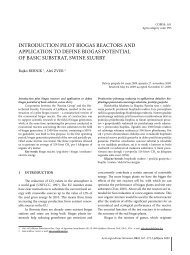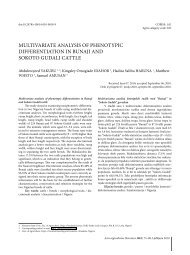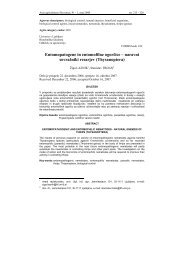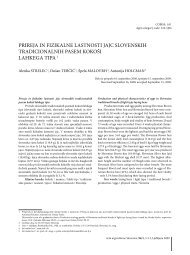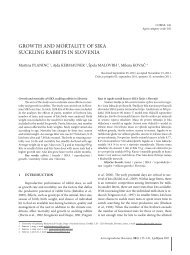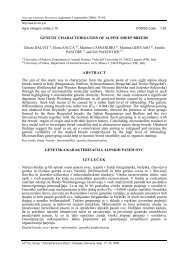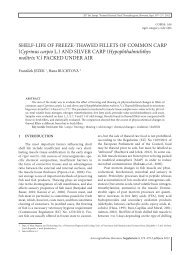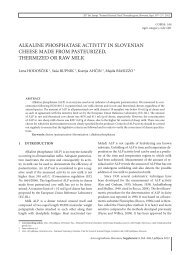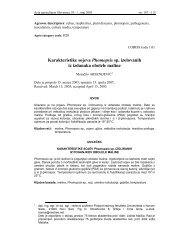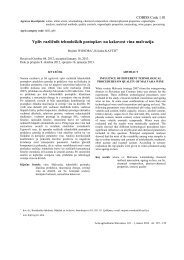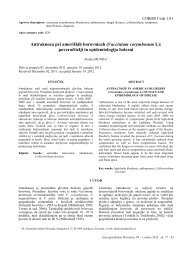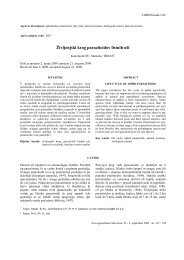THE MICROBIOLOGICAL QUALITY OF RAW MILK AFTER ...
THE MICROBIOLOGICAL QUALITY OF RAW MILK AFTER ...
THE MICROBIOLOGICAL QUALITY OF RAW MILK AFTER ...
You also want an ePaper? Increase the reach of your titles
YUMPU automatically turns print PDFs into web optimized ePapers that Google loves.
Acta agriculturae Slovenica, 92(november 2008)1, 61–74.<br />
http://aas.bf.uni-lj.si<br />
Agris category codes: Q03 COBISS Code 1.01<br />
<strong>THE</strong> <strong>MICROBIOLOGICAL</strong> <strong>QUALITY</strong> <strong>OF</strong> <strong>RAW</strong> <strong>MILK</strong> <strong>AFTER</strong> INTRODUCING <strong>THE</strong><br />
TWO DAY'S <strong>MILK</strong> COLLECTING SYSTEM<br />
Karmen GODIČ TORKAR a) and Slavica GOLC TEGER b)<br />
a)<br />
Univ. of Ljubljana, College of Health Studies, Poljanska 26 a, SI-1000 Ljubljana, Slovenia, Ass.Prof., Ph.D.,<br />
M.Sc., e-mail: karmen.torkar@vsz.uni-lj.si.<br />
b)<br />
Univ. of Ljubljana, Biotechnical Fac., Dept. of Animal Science, Groblje 3, SI-1230 Domžale, Slovenia, Ass.Prof.,<br />
Ph.D., M.Sc., e-mail: slavica.golc@bfro.uni-lj.si.<br />
Received July 29, 2008, accepted October 15, 2008.<br />
Delo je prispelo 29. julija 2008, sprejeto 15. oktobra 2008.<br />
ABSTRACT<br />
This study was carried out to investigate the quality of raw milk after the decision of the dairies<br />
to collect the milk every two days and not daily as it has been performed till the year 2005. In<br />
wider central Slovenian production area we collected in winter and summer season 203 raw milk<br />
samples obtained from farm bulk milk tanks, collecting points and transportation tanks at the<br />
entrance to the dairy was studied. The total bacterial count, the number of coliforms,<br />
psychrotrophic micro-organisms, coagulase-positive staphylococci, yeasts and moulds were<br />
analysed using standard methods. The presence of mould species and production of aflatoxins<br />
were studied as well. The total bacterial count was higher than 100 000 cfu/ml in 48 (23.6%) out<br />
of all tested samples. Its mean value in all milk samples was 4.5 log10 cfu/ml * . The mean<br />
numbers of coliform bacteria, psychrotrophic micro-organisms, yeasts and moulds together, and<br />
coagulase-positive staphylococci were 2.1 log10 cfu/ml, 3.7 log10 cfu/ml, 2.3 log10 cfu/ml and<br />
1.97 log10 cfu/ml, respectively. The yeasts were present in 95.0% of raw milk samples with the<br />
mean concentration of 1.7 log10 cfu/ml. Moulds were found in 63.3% of raw milk samples, their<br />
mean concentration was 0.6 log10 cfu/ml. Isolated mould strains belonged to genera Geotrichum<br />
(51.5%), Aspergillus (33.8%), Mucor (5.9%), Fusarium (2.9%) and Penicillium (2.9%). None of<br />
the isolated Aspergillus strains with typical growth on AFPA medium produced aflatoxin M1 on<br />
YES or YGC medium supplemented with Methyl-β-cyclodextrin.<br />
Key words: raw milk / microbiological quality / total bacterial count / moulds / aflatoxin M1<br />
MIKROBIOLOŠKA KAKOVOST SUROVEGA MLEKA PO UVEDBI SISTEMA<br />
DVODNEVNEGA ZBIRANJA<br />
IZVLEČEK<br />
Preučevali smo mikrobiološko kakovost odkupljenega surovega mleka po odločitvi mlekarn, da<br />
bodo mleko zbirale vsake dva dni in ne več dnevno, kot so to izvajale do konca leta 2005. V<br />
osrednjem proizvodnem področju Slovenije smo v zimskem in letnem obdobju odvzeli 203<br />
vzorcev mleka iz hladilnih bazenov posameznih proizvajalcev, zbiralnic ter transportnih cistern<br />
na sprejemu mlekarne. S standardnimi mikrobiološkimi metodami smo ugotavljali skupno<br />
število aerobnih mezofilnih mikroorganizmov, koliformnih in psihrotrofnih mikroorganizmov,<br />
število kvasovk in plesni ter koagulaza-pozitivnih stafilokokov. Ugotavljali smo tudi prisotnost<br />
posameznih vrst plesni in njihovo sposobnost tvorbe aflatoksinov. Skupno število<br />
mikroorganizmov je presegalo 100.000 ke/ml † v 48 (23,6 %) od vseh preiskanih vzorcev.<br />
* Abbreviations: cfu/ml = the number of colony forming units per millilitre of the sample.<br />
† Kratice: ke/ml = število kolonijskih enot v ml vzorca.
62<br />
Acta agriculturae Slovenica, 92(november 2008)1.<br />
Njihovo povprečno število v vseh vzorcih je bilo 4,5 log10 ke/ml. Povprečno število koliformnih<br />
mikroorganizmov je znašalo 2,1 log10 ke/ml, število psihrotrofnih mikroorganizmov 3,7 log10<br />
ke/ml, skupno število kvasovk in plesni 2,3 log10 ke/ml in število koagulaza-pozitivnih<br />
stafilokokov 1,97 log10 ke/ml. Kvasovke s povprečno koncentracijo 1,7 log10 ke/ml smo<br />
ugotovili v 95 % vzorcev, plesni s povprečno koncentracijo 0,6 log10 ke/ml pa v 63,3 % vzorcev.<br />
Najpogosteje smo izolirali plesni iz rodov Geotrichum (51,5%), Aspergillus (33,8 %), Mucor<br />
(5,9%), Fusarium (2,9%) in Penicillium (2,9%). Nobeden izmed izoliranih sevov iz rodu<br />
Aspergillus, ki je kazal značilno rast na gojišču AFPA, ni na gojiščih YES in YGC z metil-βciklodekstrinom<br />
tvoril aflatoksina M1.<br />
Ključne besede: surovo mleko/ mikrobiološka kakovost / skupno število mikroorganizmov / plesni / aflatoksin M1<br />
INTRODUCTION<br />
Milk is a complex biological fluid and by its nature, a good growth medium for many microorganisms.<br />
Because of the specific production it is impossible to avoid contamination of milk<br />
with micro-organisms therefore the microbial content of milk is a major feature in determining<br />
its quality (Rogelj, 2003). Bacterial contamination of raw milk can originate from different<br />
sources: air, milking equipment, feed, soil, faeces and grass (Coorevits et al., 2008). The number<br />
and types of micro-organisms in milk immediately after milking are affected by factors such as<br />
animal and equipment cleanliness, season, feed and animal health (Rogelj, 2003). It is<br />
hypothesized that differences in feeding and housing strategies of cows may influence the<br />
microbial quality of milk (Coorevits et al., 2008). Rinsing water for milking machine and<br />
milking equipment washing also involve some of the reasons for the presence of a higher number<br />
of micro-organisms including pathogens in raw milk (Bramley, 1990).<br />
After milking, milk is cooled, which additionally influence the dynamic of microbial process<br />
(Rogelj, 2003).<br />
The conditions during storage and transport in refrigerated tanks cause the raw milk<br />
microbiota to change from predominantly Gram-positive to predominantly Gram-negative<br />
organisms as they grow. Gram-negative bacteria usually account for more than 90% of the<br />
microbial population in cold raw milk that has been stored. The Gram-negative flora is<br />
composed mainly of psychrotrophic species of Pseudomonas, Achromobacter, Aeromonas,<br />
Serratia, Alcaligenes, Chromobacterium, Flavobacterium and Enterobacter (Garcia-Armesto et<br />
al., 1997; Sørhaug et al., 1997; Ryser, 1999; Martins et al., 2006).<br />
Frank (1997) also mentioned the presence of other genera: Enterococccus, Proteus,<br />
Lactococcus, Streptococcus, Leuconostoc, Lactobacillus, Microbacterium, Propionibacterium,<br />
Micrococcus, Bacillus and coliforms. Organisms unable to grow at refrigeration temperatures<br />
remain at low numbers, implying that temperature is an important factor contributing to the<br />
prevalence and proliferation of specific organisms in the milk (Jay, 1996; Frank, 1997).<br />
Pasteurization of raw milk is effective in eliminating all but the thermoduric microorganisms<br />
of the genera Microbacterium, Micrococccus, Streptococcus, Lactobacillus, Bacillus,<br />
Clostridium, the coryneforms, and occasionally some Gram-negative rods (Jay, 1996).<br />
Psychrotrophs can grow at refrigeration temperatures below 7 °C, produce enzymes toxins and<br />
other metabolites (Jay, 1996) and contribute to high standard plate counts in both raw and<br />
pasteurised milk. Since milk is currently handled and stored at low temperatures, these<br />
organisms hinder efforts to increase the shelf life of pasteurised milk (Frank, 1997). Most of<br />
these bacteria produce extracellular proteolytic and lypolitic enzymes that are secreted into the<br />
milk. Many of these enzymes are not inactivated by pasteurizing at 72 °C for 15 s or by Ultra-<br />
High Temperature (UHT) treatment (Griffiths et al., 1981). The residual activities of these<br />
enzymes can reduce the organoleptic quality and shelf life of processed milk products (Fairbairn<br />
et al., 1986). Pasteurization cannot guarantee the absence of microorganisms, when they are
Godič Torkar, K. and Golc Teger, S. The microbiological quality of raw milk … day's milk collecting system.<br />
present in large numbers in raw milk or due to post-pasteurization contamination. (Salmeron et<br />
al., 2002).<br />
Examination for the presence and number of specific micro-organisms is, therefore, an<br />
integral part of any quality control or quality assurance plan and it may be applied to a number of<br />
areas: raw materials, intermediate samples, finished products, or environmental/equipment sites.<br />
Milk-borne and milk-product borne outbreaks represent 2–6% of bacterial food-borne outbreaks<br />
reported by surveillance systems from several countries (De Buyser et al., 2001).<br />
Yeasts and moulds in some cheese types can periodically cause problems, both economic and<br />
sensory. They usually present in raw milk do not survive pasteurization; their presence in<br />
pasteurized milk and other milk products is caused by re-infection during manufacturing<br />
(Nelson, 1981; Jodral et al., 1993). The contamination of milk products, particularly cheeses is<br />
caused by yeasts and moulds present in the environment of cheese factories, like walls and<br />
shelves of ripening rooms, air, equipment, water, milk, brine, etc. (Chapman and Sharpe, 1990;<br />
Jay, 1992). Of course, the presence of yeasts and moulds in raw milk is undesired, when in<br />
manufacturing unpasteurized milk is used.<br />
Yeasts themselves are not commonly the cause of defect in dairy products unless they ferment<br />
lactose. In this case, they can grow rapidly and produce a characteristic yeasty or fruity flavour<br />
and obvious gas (Davis and Wilbey, 1990). They also produce metabolites, e.g. short-chain fatty<br />
acids and other compounds, with known toxic effects against undesired micro-organisms in the<br />
intestinal tract (Jakobsen and Narvhus, 1996).<br />
Moulds are important in milk, which is used for the manufacture of cheese and other dairy<br />
products. The presence of wild types of moulds is undesirable as they may influence the<br />
organoleptic characteristics of the cheeses, they can produce mycotoxins and represent a<br />
potential health risk (Jodral et al., 1993; Wouters, et al., 2002). Mycotoxins are toxic metabolites<br />
produced by various fungi growing in a wide range of food and animal feedstuffs. The main<br />
mycotoxins that occur frequently are aflatoxins, ochratoxins, patulins, trichothecenes and<br />
zearalenones (Gilbert, 2002). The major toxigenic species of fungi belong to genera Aspergillus,<br />
Fusarium, Acremonium and Phomopsis (D’Mello and Macdonald, 1997). Aflatoxins are<br />
mycotoxins produced as carcinogenic, teratogenic and mutagenic secondary metabolites by some<br />
species of genus Aspergillus (Frisvad et al., 2005) Aflatoxin B1 represents the highest degree of<br />
toxicity for animals, followed by aflatoxin M1, G1, B2 and G2 (Gourama and Bullerman, 1995).<br />
AFM1 may be found in the milk of animals that have been fed with feed containing AFB1.<br />
The objective of this work was to evaluate the level of microbiological contamination of raw<br />
milk samples taken from farm cooling milk tanks, collecting points and from bulk raw milk from<br />
transportation tanks at the entrance to a dairy. This study was carried out to investigate the<br />
quality of raw milk after the decision of the dairies to collect the milk every two days and not<br />
daily as it has been performed till the year 2005.<br />
We wished to found out the differences in number of micro-organisms between milk samples<br />
taken in winter and summer season and at different collecting stages.<br />
Our interest was also the identification of moulds isolated from samples and the detection of<br />
their aflatoxin production.<br />
Sampling<br />
MATERIALS AND METHODS<br />
The collection of the raw milk samples took place in January to February and May to June<br />
2006 at the central part of Slovenia. A total of 203 raw milk samples were analysed, of which<br />
100 samples were taken in winter and 103 of them in summer season. In both seasons 60 of<br />
63
64<br />
Acta agriculturae Slovenica, 92(november 2008)1.<br />
samples were obtained from collecting points and farm bulk milk tanks, while 40 and 43 of them<br />
were collected from transportation tanks at the entrance to the dairy in winter and in summer,<br />
respectively. The milk samples were taken in accordance with the instructions given in ISO/DIS<br />
707 (1995). Samples were collected in sterile bottles and transported to the laboratory in cold<br />
chain under temperature 6 °C and analysed within 2 hours of sampling.<br />
Mediums, reagents and reference strains<br />
The samples were serially decimal diluted with Quarter strength Ringer’s solution (Merck,<br />
Germany) and appropriate dilutions plated on media using the pour plate method (ISO/FDIS<br />
8261 (E), 2001).<br />
For the enumeration of coagulase-positive staphylococci (Staphylococcus aureus and other<br />
species) the Baird Parker with RPF supplement agar (Biokar Diagnostics, France) was used<br />
(SIST EN ISO 6888-2, 1999).<br />
The enumeration of coliform micro-organisms was carried out on VRBL agar (Merck,<br />
Germany) according to the standard ISO 4832 (2006).<br />
The presence and number of total bacterial count and psychrotrophic micro-organisms were<br />
evaluated on PCA agar (Merck, Germany) with the addition of 0.1% w/v (1 g per 1 l of medium)<br />
of skimmed milk powder. The plates were incubated at 30 °C for 72 hours for aerobic mesophilic<br />
counts (EN ISO 4833, 2003) and at 6.5 °C for 10 days for psychrotrophic micro-organisms (ISO<br />
6730, 2005).<br />
For the enumeration of yeasts and moulds the YGC agar (Merck, Germany) was used<br />
according to the standard ISO 6611(E) (2004).<br />
Aspergillus flavus / parasiticus agar (AFPA base) (Oxoid, England), supplemented with<br />
chloramphenicol selective supplement (Oxoid, England) was used for isolation and partially<br />
identification of moulds. Yeast extract sucrose agar (YES) (Samson and Hoekstra, 2000) and<br />
also yeast glucose cloramphenicol agar (YGC), both supplemented with 0.3% methyl-βcyclodextrin<br />
(Sigma, Germany) and 0.6% sodium deoxycholate (Sigma, Germany) were used for<br />
determination of aflatoxin production (Fente et al., 2001; Ordaz et al., 2003).<br />
Quarter strength Ringer’s solution (Merck, Germany) was used for decimal dilution of<br />
samples.<br />
Reference strains: A. flavus EXF 523 and A. flavus EXF 438 were kindly given as a gift from<br />
University of Ljubljana, Biotechnical Faculty, Departement for Biology, Slovenia.<br />
Inoculation and enumeration of micro-organisms<br />
The milk samples were serially decimal diluted with Quarter strength Ringer’s solution and<br />
appropriate dilutions were inoculated by pouring the plates with chosen medium (EN ISO 8261<br />
(E), 2001).<br />
Moulds isolation and identification<br />
Each morphologically different mould colony from the plates with YGC medium was picked<br />
up, transferred to YGC and AFPA mediums and incubated for 5 days at 25 °C and for 42 hours<br />
at 30 °C, respectively.<br />
Primary classification of colonies from solid mediums YGC and AFPA was based on colony<br />
characteristics (pigmentation, shape, background colour) and on microscopic examination of<br />
moulds using immersion objective magnifications 100/1.30 and 160/0.17, according to Samson<br />
and Hoekstra (2000). The identification of strains A. flavus and A. parasiticus was confirmed by<br />
reverse, yellow to orange pigmentation on AFPA medium (Pitt et al., 1983).
Godič Torkar, K. and Golc Teger, S. The microbiological quality of raw milk … day's milk collecting system.<br />
Aflatoxin production<br />
For the examination of aflatoxin production at isolated moulds from the genus Aspergillus,<br />
the YES and YGC medium, supplemented with 0.3% methyl-β-cyclodextrin and 0.6% sodium<br />
deoxycholate were used (Fente et al., 2001; Ordaz et al., 2003). The plates with inoculated<br />
strains were incubated for 3 days at 28 °C and then observed under UV light (365 nm).<br />
Statistical analyses<br />
For statistical analyses, the SAS/STAT (2000) was used. Descriptive statistics including<br />
average, standard deviation, variability coefficient, minimum and maximum was done. The<br />
Pearson’s correlation coefficients between variables log number of different groups of tested<br />
micro-organisms in milk samples were calculated.<br />
RESULTS AND DISCUSSION<br />
According the Regulatives EU (Regulation 853, 2004) the rolling geometric average of total<br />
number of micro-organisms should not exceed 100.000 per ml of raw cow’s milk from primary<br />
production. The rolling geometric average should be calculated over a two month period, with at<br />
least two samples per month. In Slovenia, the microbiological quality of raw milk is very good<br />
and is comparable with milk quality in dairy developed countries. In the year 1994 only about<br />
60% of milk, delivered to dairies, contained up to 100.000 micro-organisms per millilitre, while<br />
in the year 2005 already 99.5% out of all 448.5 millions litres of raw milk, delivered to dairies,<br />
contained less than 100.000 m.o./ml. Up to 50.000 micro-organisms per millilitre contained<br />
93.6% of milk (Valjavec, 2006).<br />
Since the year 2005 some Slovenian dairies have collected the milk from the farmers every<br />
two days and not daily any more. Such milk stays in the cooling pools or tanks two days and is<br />
mixed with warm milk after every new milking. The microbiological quality and the correlation<br />
between different groups of micro-organisms in such milk are different in comparison to the<br />
fresh milked milk, which is cooled immediately and take to the dairy daily.<br />
In this study we aimed to investigate the microbiological quality of 203 raw milk samples,<br />
collecting in winter (100 samples) and summer season (103 samples). We determined the total<br />
bacterial count higher than 100.000 cfu/ml in 48 (23.6%) out of all tested samples.<br />
The mean total aerobic mesophilic micro-organisms, coliform bacteria, psychrotrophic microorganisms,<br />
coagulase-positive bacteria, and yeasts and moulds counts were determined as 4.5<br />
log10 cfu/ml, 2.0 log10 cfu/ml, 3.7 log10 cfu/ml, 1.9 log10 cfu/ml and 2.3 log10 cfu/ml,<br />
respectively. The basic statistic parameters were determined in the Table 1. The highest mean<br />
values as well as minimal and maximal values were found for the number of total mesophilic<br />
aerobic count. The lowest number between all tested groups of micro-organisms was evaluated<br />
for coagulase-positive staphylococci (Table 1).<br />
Aaku et al. (2004) and Arenas et al. (2004) reported on 5.5·10 6 cfu/ml and 10 6 to 10 7 cfu/ml<br />
of the total number of micro-organisms in pooled raw milk, respectively, which is higher than in<br />
our experiment (3.2·10 4 cfu/ml).<br />
The average number of coliforms, yeasts and moulds, and coagulase-postive staphylococci<br />
represented only 0.37%, 0.62% and 0.27% of the mean number of total bacterial count,<br />
respectively.<br />
The mean number of almost all groups of micro-organisms was higher in summer season, but<br />
the correlations between their numbers and the total bacterial count stayed very similar in winter<br />
and summer season. The total bacterial count exceeded the 10 5 cfu/ml in 15% of winter samples<br />
and in 32% of summer samples. It decreased from summer to winter for 46.5%, the number of<br />
65
66<br />
Acta agriculturae Slovenica, 92(november 2008)1.<br />
coliforms was lower for 48.2%, the number of yeasts and moulds for 45.0% and the number of<br />
coagulase-positive staphylococci for 5.0%.<br />
Table1. The basic statistical parameters for the log values of the number of individual<br />
groups of micro-organisms per millilitre of 203 tested samples<br />
Preglednica 1. Osnovni statistični parametri za logaritemske vrednosti števila posameznih<br />
skupin mikroorganizmov v mililitru 203 preskušenih vzorcev<br />
Groups of m.o.<br />
Number of micro-organisms per ml of the sample, in log10<br />
Število mikroorganizmov v ml vzorca, v log10<br />
Skupine m.o. Average<br />
Povprečje<br />
Median<br />
Mediana<br />
Sd KV Min Max<br />
SŠMO 4.53 4.55 0.55 12.15 2.60 6.04<br />
KF 2.09 2.17 1.07 51.69 0.00 4.53<br />
KV-PL 2.32 2.44 0,71 30.95 0.30 4.18<br />
PS 3.75 3.93 0.89 23.75 2.00 5.50<br />
KPS 1.97 2.17 0.63 31.90 1.00 3.17<br />
m.o.: micro-organisms / mikroorganizmi; Sd: standard deviation / standardni odklon; KV: coefficient of variation /<br />
koeficient variabilnosti; Min: minimum value / najmanjša vrednost; Max: maximum value / največja vrednost;<br />
SŠMO: total bacterial count / skupno število aerobnih mezofilnih mikroorganizmov; KF: coliform microorganisms /<br />
koliformni mikrooganizmi; KV, PL: yeasts and moulds / kvasovke in plesni; PS: psychrotrophic microorganisms /<br />
psihrotrofni mikroorganizmi; KPS: coagulase-positive staphylococci / koagulaza-pozitivni stafilokoki<br />
The number of psychrotrophic micro-organisms was the exception in a few views. The mean<br />
of the psychrotrophs was 3.7 log10 cfu/ml and represented even 17.1% of the mean of total<br />
bacterial count. Their number was in winter higher than in summer for 6.9% (Fig. 1).<br />
log10 m.o./ml<br />
5<br />
4,5<br />
4<br />
3,5<br />
3<br />
2,5<br />
2<br />
1,5<br />
1<br />
0,5<br />
0<br />
SŠMO KF KV,PL PS KPS<br />
groups of mico-organisms/skupine mikroorganizmov<br />
summer/poletje winter/zima<br />
KF: coliform micro-organisms / koliformni mikroorganizmi; KV, PL: yeasts and moulds / kvasovke in plesni; PS: psychrotrophic<br />
micro-organisms / psihrotrofni mikroorganizmi; KPS: the coagulase-positive staphylococci / koagulaza-pozitivni stafilokoki<br />
Figure 1. Average log numbers of the individual groups of micro-organisms per millilitre of<br />
milk samples in both seasons.<br />
Slika 1. Povprečne logaritemske vrednosti posameznih skupin mikroorganizmov v mililitru<br />
vzorcev mleka v obeh sezonah.
Godič Torkar, K. and Golc Teger, S. The microbiological quality of raw milk … day's milk collecting system.<br />
The number of all tested groups of micro-organisms was higher in samples of raw bulk milk,<br />
collected from transportation tanks at the entrance of the dairy. The highest differences between<br />
samples taken from individual farms and from transportation tanks were in number of coliforms<br />
(about 1.44 log10 cfu/ml). As it is represented in the Fig. 2, the mean total bacterial count,<br />
number of coliforms, yeasts and moulds, psychrotrophic micro-organisms and coagulase-positive<br />
staphylococci were in milk from transportation tanks higher than in milk from individual farm<br />
tanks for 10.2%, 96.3%, 36.1%, 26.9% and 6.4%, respectively. The total bacterial count<br />
exceeded 100.000 cfu/ml in 21.7% of samples from farm bulk milk tanks and in 27.5% of<br />
samples from transportation tanks at the entrance of the dairy.<br />
log10 m.o./ml<br />
5<br />
4,5<br />
4<br />
3,5<br />
3<br />
2,5<br />
2<br />
1,5<br />
1<br />
0,5<br />
0<br />
SŠMO KF KV,PL PS KPS<br />
groups of micro-organisms/skupine mikroorganizmov<br />
farms/kmetije tanks/cisterne<br />
KF: coliform micro-organisms / koliformni mikroorganizmi; KV, PL: yeasts and moulds / kvasovke in plesni; PS: psychrotrophic<br />
micro-organisms / psihrotrofni mikroorganizmi; KPS: the coagulase-positive staphylococci / koagulaza-pozitivni stafilokoki<br />
Figure 2. Average values of the log number of the individual groups of micro-organisms per<br />
millilitre of milk samples from farm bulk tanks and transportation tanks at the entrance<br />
of the dairy.<br />
Slika 2. Povprečne logaritemske vrednosti posameznih skupin mikroorganizmov v mililitru<br />
vzorcev mleka iz hladilnih bazenov pri posameznih proizvajalcih in iz transportnih<br />
cistern na sprejemu mlekarne.<br />
Almost all correlations between individually groups of micro-organisms were in both seasons<br />
highly statistically significant (P ≤ 0.0001), except for coagulase-positive staphylococci there<br />
was no statistically significant correlation with any other tested group (Table 2).<br />
The correlation of the number of coliforms with total bacterial count was understandable,<br />
because the colifirms represented a part of the total bacterial count. From the same reason there<br />
was also a correlation between the number of coliform and psychrotrophic micro-organisms,<br />
because a lot of coliform bacteria are capable to growth at law temperatures. Bramley (1990)<br />
reported that some species of the genera making up the coliform group of bacteria are<br />
psychrotrophic and constitute 10–30% of the whole group of micro-organisms, the majority of<br />
these coliforms are Aerobacter spp. In our experiment the number of coliforms represented 2.1%<br />
of the number of psychrotrophs.<br />
The incidence of coliforms in raw milk has received considerable attention, partly due to their<br />
association with contamination of faecal origin and the consequent risk of more pathogenic<br />
67
68<br />
Acta agriculturae Slovenica, 92(november 2008)1.<br />
faecal organisms being present, partly because of the spoilage their growth in milk at ambient<br />
temperatures can produce, and not least due to the availability of sensitive and rapid tests for<br />
detecting and enumerating coliforms. Coliform counts regularly in excess of 100 cfu/ml are<br />
considered by some authorities as evidence of unsatisfactory production hygiene. Sporadic high<br />
coliform counts may also be a consequence of unrecognised coliform mastitis, mostly caused by<br />
E. coli. The coliform micro-organisms are found also on the surface of the underwashed or<br />
moisture milking equipment, (Bramley, 1990, Rogelj, 2003).<br />
Table 2. The influence of the season and the place of sampling (farm bulk milk tanks and<br />
transportation tanks at the entrance of the dairy) on the log number of tested<br />
microorganisms from individual groups<br />
Preglednica 2. Vpliv sezone in mesta odvzema vzorca (hladilni bazeni pri posameznih<br />
proizvajalcih ali transportne cisterne na sprejemu mlekarne) na logaritemsko<br />
število mikroorganizmov iz posameznih skupin<br />
Groups of m.o.<br />
Season / sezona Sampling place / mesto vzorčenja<br />
Skupine m.o. F P F P<br />
SŠMO 19.71 < 0.0001 59.42 < 0.0001<br />
KF 7.04 0.0084 234.13 < 0.0001<br />
KV-PL 10.91 0.0011 102.64 < 0.0001<br />
PS 0.18 0.6679 68.07 < 0.0001<br />
KPS 0.05 0.81 1.87 0.17<br />
m.o.: micro-organisms / mikroorganizmi; SŠMO: total bacterial count / skupno število aerobnih mezofilnih<br />
mikroorganitmov; KF: coliform microorganisms / koliformni mikrooganizmi; KV, PL: yeasts and moulds /<br />
kvasovke in plesni; PS: psychrotrophic microorganisms / psihrotrofni mikroorganizmi; KPS: coagulase-positive<br />
staphylococci / koagulaza-pozitivni stafilokoki; F: variance ratio / vrednost variance; P ≤ 0.05: statistically<br />
significant influence / statistično značilen vpliv; P ≤ 0.001: highly stsatistically significant influence / visoko<br />
statistično značilen vpliv; P > 0.05: no statistically significant influence / ni statistično značilnega vpliva<br />
In our case the average number of coliforms was about 120 cfu/ml. In about 10% of winter<br />
samples taken exclusively from farm tanks we did not detect any coliforms with standard plate<br />
count method.<br />
Bramley (1990) also reported, that the number of psychrotrophs should represent about<br />
10–50% of total bacterial count, which is in the agreement with our results, because the number<br />
of psychrotrophic micro-organisms represented 10.9% of total bacterial count in summer and<br />
21.9% of them in winter. We suppose, that the cooling of raw milk in cooling tankers at<br />
individual milk producers or farms was very intensive and the environmental temperatures did<br />
not influence on the microbiological quality of milk, even if it was kept there two days. Villar et<br />
al. (1996) also reported about good correlation between the total bacterial count and<br />
psychrotrophic count (r = 0.82). The correlation coefficient between these two groups in our<br />
experiment was r = 0.71.<br />
Leitner et al. (2008) established that refrigerated storage of good-quality milk from a single<br />
cow resulted in moderate deterioration of its quality, low level of bacterial growth (standard plate<br />
and psychrotroph counts), and low small losses of curd yield. When milk was collected from<br />
farm bulk milk tanks and from dairy silos, its quality deteriorated faster than that of single-cow<br />
milk resulting in high bacteria counts and high loss of curd yield, most of which was already<br />
apparent for the farm bulk milk tank. Statistical analyses in his study did not reveal any<br />
significant interaction between bacterial growth, milk composition, somatic cell count, and curd<br />
yield loss, indicating that other mechanisms such as enzymatic activity might be responsible.<br />
From the comparison between the high-quality milk from an uninfected cow's udder and the
Godič Torkar, K. and Golc Teger, S. The microbiological quality of raw milk … day's milk collecting system.<br />
commingled milk on the farm and in the dairy silos, it appears that introduction of milk coming<br />
from infected udders might cause curd yield loss (Leitner et al., 2008).<br />
Our results agreed with the Leitner’s comments (2008), because we established the<br />
statistically significant influence (P ≤ 0.05) of the season and the place of sampling (individual<br />
farms, transportation tanks) on the total bacterial count, number of coliforms and yeasts and<br />
moulds. The influence of the place of sampling was determined also on the number of<br />
psychrotrophic micro-organisms (Table 2).<br />
To avoid the increase of the number of micro-organisms the European Regulative 853 (2004)<br />
recommends that immediately after milking, milk must be held in a clean place designed and<br />
equipped to avoid contamination. It must be cooled immediately to not more than 8 °C in the<br />
case of daily collection, or not more than 6 °C if collection is not daily. During transport the cold<br />
chain must be maintained and on arrival at the establishment of destination, the temperature of<br />
the milk must not be more that 10 °C (Regulation EC 853, 2004).<br />
The standard deviations and variability coefficients were in most cases high, because there<br />
were rather large differences in number of micro-organisms between samples (Table 1).<br />
The number of coagulase-positive staphylococci was not in statistically significant correlation<br />
with other groups of micro-organisms and was not dependent on the season (Table 2).<br />
Coagulase-positive staphylococci may cause human disease through the production of toxins.<br />
The formation of effective levels of toxin requires a high number of micro-organisms<br />
(approximately 10 5 –10 6 micro-organisms per gram of food) at a pH value greater than 5 and so<br />
the presence of coagulase-positive staphylococci at a low level does not necessarily constitute a<br />
hazard. Dairy-related outbreaks of staphylococcal intoxication have been attributed to raw milk,<br />
dried milk, cheese and ice cream. Coagulase-positive staphylococci may be present in raw milk<br />
from the surfaces of animals, udder and teat canals of a cow, particularly if lesions are present.<br />
Also, the nasal area and hands of humans are recognised sites of contamination: poor personal<br />
hygiene can result in the contamination of milk and dairy products. Essential to the production of<br />
toxin is the growth of micro-organisms. In general, Staphylococcus aureus and the related<br />
species Staphylococcus intermedius and Staphylococcus hyius do not multiply at temperatures<br />
below 8 °C, and 10 °C is the minimum for toxin production. These micro-organisms are,<br />
however, resistant to salt. Pasteurisation will be effective against them but, if toxins are present,<br />
the toxins will not be inactivated. The higher counts of Staphylococcus recorded in spring, when<br />
milk yields are at their peak, are a cause for concern and mammary infections (Anonim., 1994;<br />
Bramley, 1990). De Buyser et al. (2001) reported that Staphylococcus aureus was by far the<br />
most frequent pathogen associated with food pathogen outbreaks (85.5% of the outbreaks) in<br />
France, followed by Salmonella (10.1%), E. coli (3%), L. monocytogenes (3%) and C. jejuni<br />
(1.5%) outbreaks.<br />
In our experiment coagulase-positive staphylococci were found in all tested samples, but their<br />
number did not exceed 1300 bacteria per ml.<br />
It is documented that yeasts occur in raw milk at insignificant numbers (Fleet, 1990) probably<br />
due to competitive utilization for the growth substrates by psychrotrophic bacteria of milk or<br />
owing to inhibition by metabolites excreted by bacteria (Viljoen, 2001).<br />
The mean number of yeasts and moulds found in raw milk samples of our study was 2.3 log10<br />
cfu/ml, which is comparable to the mean yeast count (2.64 log10 cfu/ml) in raw milk from farms<br />
located in different areas of Sardinia (Fadda et al., 2004). The maximum values of yeasts in raw<br />
milk samples from our producers were 4.1 log10 cfu/ml.<br />
In all milk samples, two or more mould species were found, 210 of them were successfully<br />
isolated and classified to genera Geotrichum (51.5% of strains), Aspergillus (33.8% of strains),<br />
Mucor (5.9% of strains), Fusarium (2.9% of strains) and Penicillium (2.9% of strains). The<br />
results are close to results of Jodral et al. (1993) who reported that the genera most frequently<br />
isolated in the raw milk were Geotrichum (76.5%), Fusarium (45.3%) and Aspergillus (31,2%).<br />
69
70<br />
Acta agriculturae Slovenica, 92(november 2008)1.<br />
O’Brien et al. (2005) established about 91% of baled grass silage contaminated with moulds,<br />
which mostly belonged to genera Penicillium, Geotrichum, Fusarium and mucoraceous species.<br />
These genera were found in our raw milk samples to, so it could be expected that the feed was<br />
one of the possible sources of contamination of raw milk in spite of Finne Kure et al. (2004)<br />
adduced proofs that there are many possible sources of contamination of raw milk, beside the<br />
feed also the air and the environment.<br />
We also expected the higher number of yeasts and moulds in milk sampled in winter, when<br />
the pasture or the hay was replaced by conserved or ensiled feed. Many authors namely reported<br />
on higher number of yeasts, moulds and consecutively the higher concentration of mycotoxins in<br />
ensiled feed, which was used mostly in winter season. These micro-organisms were very often<br />
transferred from feed to milk (Blanco et al., 1988; Lopez et al., 2003; Kamkar, 2005).<br />
Surprisingly, the average number of yeasts and moulds in raw milk samples was a little higher in<br />
summer (2.49 log10 cfu/ml) than in winter (2.23 log10 cfu/ml), while the minimal and maximal<br />
values were higher in winter, as we expected.<br />
All 210 mould strains isolated from milk samples as well as standard strains A. flavus were<br />
inoculated on A. flavus/ parasiticus agar (AFPA). Aspergillus strains grew on the medium, but<br />
except reference strains A. flavus EXF 523 and A. flavus EXF 438 only one strain, previously<br />
classified as genus Aspergillus produced a distinctive bright orange yellow reverse colour on<br />
AFPA medium as described by Frädberg et al. (2003) and thus identified as A. flavus or A.<br />
parasiticus species.<br />
Only about 70% out of 24 Aspergillus strains, growing on YGC medium, were able to form<br />
the colonies on YES medium supplemented with methyl-β-cyclodextrin and 0.6% sodium<br />
deoxycholate. None of isolated strains could cause a typical white fluorescent zone around the<br />
colonies, visible under UV light. We could conclude, that tested mould strains did not produce<br />
aflatoxins on these two media.<br />
In our study it was found out that only one strain belonged to species A. flavus / parasiticus<br />
under typical growth on AFPA medium. A. flavus is not a common species on cheese. Most<br />
studies showed that aflatoxins could only be produced in milk and on cheese at temperatures<br />
higher than 10 °C and a limiting aw of 0.79 was found for growth of A. flavus and aflatoxin<br />
production (Scott, 1989).<br />
CONCLUSIONS<br />
− In our study 76.4% out of total 203 tested raw milk samples contained less than 100.000<br />
cfu/ml. There were statistical significant differences in total bacterial count between<br />
winter and summer samples and between samples taken from individual farm bulk milk<br />
tanks and transportation tanks at the entrance of the dairy.<br />
− The total bacterial count exceeded 100.000 cfu/ml in 21.7% of samples from farm bulk<br />
milk tanks and in 27.5% of samples from transportation tanks at the entrance of the dairy.<br />
− The number of all tested groups of micro-organisms was higher in samples of raw bulk<br />
milk, collected from transportation tanks at the entrance of the dairy. The highest<br />
differences between these samples were in number of coliforms.<br />
− The average of the psychrotrophs represented even 17.1% of the average total bacterial<br />
count. Their number was in winter higher than in summer.<br />
− All samples contained coagulase-positive staphylococci which may be an indicator of<br />
mastitical diseases of milking cows. The health care of milking cows should be more<br />
intensive.<br />
− Isolated mould strains belonged to genera Geotrichum, Aspergillus, Mucor, Fusarium<br />
and Penicillium. None of the isolated Aspergillus strains produced aflatoxin M1.
Godič Torkar, K. and Golc Teger, S. The microbiological quality of raw milk … day's milk collecting system.<br />
− The microbiological quality of milk samples mostly suited the requirements of the<br />
dairies, although that there was the percent of raw bulk milk from transportation tanks,<br />
contained less than 100.000 m.o./ml lower (72.5%) in comparison with the data for total<br />
bacterial count of raw milk in Slovenia in the year 2005.<br />
− More attention should be focused on the cleaning of transportation tanks, appropriate<br />
handling with milk and its transportation at low temperatures from farms and collecting<br />
points to the dairies, particularly in summer season.<br />
POVZETEK<br />
Na osnovi uredbe EU (Regulation 853/2004) geometrijsko povprečje skupnega števila<br />
aerobnih mezofilnih mikroorganizmov v enem mililitru svežega kravjega mleka ne sme presegati<br />
100.000. V Sloveniji je mikrobiološka kakovost surovega mleka dobra in je primerljiva s<br />
kakovostjo mleka mlekarsko razvitih držav. Ob koncu leta 2005 se je večina slovenskih mlekarn<br />
odločilo, da bodo mleko odvažale iz zbirnih hladilnih bazenov posameznih proizvajalcev ter<br />
zbiralnic vsake dva dni in ne več dnevno. Tako mleko stoji v hladilnih bazenih, ob vsaki molži<br />
pa se v bazen dolije k ohlajenemu še sveže pomolzeno toplo mleko. Mikrobiološka kakovost in<br />
razmerje med različnimi skupinami mikroorganizmov v takem mleku se razlikuje od sestave<br />
mikroflore v mleku, ki se takoj ohladi in zbira vsakodnevno.<br />
V našem poskusu smo želeli preučiti mikrobiološko kakovost 203 vzorcev surovega mleka,<br />
od tega jih je bilo 100 odvzetih v zimskem in 103 vzorci v letnem obdobju. Vzorčili smo mleko<br />
iz zbirnih hladilnih bazenov pri posameznih proizvajalcih mleka, zbiralnicah in v transportnih<br />
cisternah ob sprejemu mleka v mlekarni. Ugotavljali smo skupno število mikroorganizmov,<br />
število koliformnih in psihrotrofnih mikroorganizmov, kvasovk in plesni ter število koagulazapozitivnih<br />
stafilokokov. Želeli smo ugotoviti prisotnost posameznih rodov plesni in tvorbo<br />
aflatoksinov pri vrstah rodu Aspergillus.<br />
Skupno število mikroorganizmov je presegalo 100.000 ke/ml v 48 (23,6 %) od vseh<br />
preiskanih vzorcev. Njihova povprečna vrednost v vseh vzorcih mleka je bila 4,5 log10 ke/ml<br />
(3.2·10 4 ke/ml). Povprečno število koliformnih mikroorganizmov je znašalo 2.1 log10 ke/ml,<br />
število psihrotrofnih mikroorganizmov 3.7 log10 ke/ml, skupno število kvasovk in plesni 2.3<br />
log10 ke/ml in število koagulaza-pozitivnih stafilokokov 1.97 log10 ke/ml. Število vseh skupin<br />
mikroorganizmov, z izjemo psihrotrofov, je bilo višje v poletnem času odvzema vzorcev, čeprav<br />
je njihovo razmerje s skupnim številom mikroorganizmov ostalo podobno v obeh sezonah.<br />
Število vseh skupin mikroorganizmov, posebno še koliformnih, je bilo višje v mleku iz<br />
transportnih cistern na sprejemu mlekarne.<br />
Kvasovke smo ugotovili v 95 % vzorcev, plesni pa v 63,3 % vzorcev. Najpogosteje smo<br />
izolirali plesni iz rodov Geotrichum (51,5 %), Aspergillus (33,8 %), Mucor (5,9 %), Fusarium<br />
(2,9 %) in Penicillium (2,9 %). Nobeden izmed izoliranih sevov iz rodu Aspergillus, ki je kazal<br />
značilno rast na gojišču AFPA, ni na gojiščih YES in YGC z metil-β-ciklodekstrinom tvoril<br />
aflatoksina M1.<br />
Ugotovili smo, da je mikrobiološka kakovost surovega mleka kljub dvodnevnemu odvozu, še<br />
vedno v večini primerov ustrezna, čeprav je bil odstotek vzorcev v mlekarni sprejetega mleka, ki<br />
so vsebovali manj kot 100.000 mikroorganizmov/ml, v primerjavi z mikrobiološko kakovostjo<br />
mleka v Sloveniji v letu 2005, nekoliko nižji (72,5 %).<br />
Iz rezultatov lahko povzamemo, da samo skupno število mikroorganizmov ni vedno realni<br />
pokazatelj mikrobiološke kakovosti mleka. Občasno je potrebno kontrolirati tudi prisotnost in<br />
število drugih skupin mikroorganizmov. Število koliformnih, psihrotrofnih in koagulazapozitivni<br />
mikroorganizmov je bilo v našem poskusu občasno visoko. Koliformni mikroorganizmi<br />
so namreč pokazatelj slabe higiene in možnega fekalnega onesnaženja, psihrotrofni<br />
71
72<br />
Acta agriculturae Slovenica, 92(november 2008)1.<br />
mikroorganizmi se množijo tudi pri nizkih temperaturah hlajenja in so pogosti kvarljivci mleka<br />
zaradi tvorbe termostabilnih proteolitičnih in lipolitičnih encimov, koagulaza-pozitivni<br />
stafilokoki pa so lahko prisotni v mleku mastitičnih krav. Tudi prisotnost gliv, kontaminentov iz<br />
okolja, je bila v vzorcih pogosta.<br />
Mikrobiološka kakovost vzorcev mleka iz transportnih cistern na sprejemu mlekarne je bila,<br />
zlasti v letnem obdobju, opazno slabša v primerjavi z vzorci iz hladilnih bazenov posameznih<br />
proizvajalcev ali zbiralnic. Zato je večjo pozornost potrebno posvetiti čiščenju transportnih<br />
cistern, pravilnemu ravnanju z zbranim mlekom in njegovemu prevozu v mlekarno ob ustrezno<br />
nizkih temperaturah.<br />
REFERENCES<br />
Aaku, E.N./ Collinson, E.K./ Gashe, B.A./ Mpuchane, S. Microbiological quality of milk from two processing plants<br />
in Gaborone Botswana. Food Control, 15(2004), 181–186.<br />
Anonymous. Recommendations for the hygienic manufacture of milk and milk based products, appendix A.1<br />
Spoilage and pathogenic bacteria in milk based products. Bulletin of the International Dairy Federation, IDF<br />
292, Brussels, Belgium, 1994, 28–32.<br />
Arenas, R./ Gonzales, L./ Bernardo, A./ Fresno, J.M./ Tornadijo, M.E. Microbiological and physico-chemical<br />
changes in Genestoso cheese, a Spanish acid curd variety, throughout ripening. Food Control, 15(2004)4,<br />
271–279.<br />
Blanco, J.L./ Dominguezs, L./ Gomez-Lucia, E./ Garayzabal, J.F.F./ Garcia, J.A./ Suarez, G. Presence of aflatoxin<br />
M1 in commercial ultra-high temperature treated milk. Applied Environmental Microbiology, 56(1988),<br />
1622–1623.<br />
Bramley, A.J./ McKinnon, C.H. The Microbiology of Raw Milk. In: Dairy Microbiology, I, (Ed.: Robinson, R.K.).<br />
London, New York, Elsevier Applied Science, 1990, 171.<br />
Chapman, H.R./ Sharpe, M.E. Microbiology of Cheese. In: Dairy Microbiology (Ed.: Robinson, R.K.), London and<br />
New Jersey, Applied Science Publishers, 1990, 203–290.<br />
Coorevits, A./ De Jonghe, V./ Vandroemme, J./ Reekmans, R./ Heyrman, J./ Messens, W./ De Vos, P./ Heyndrickx,<br />
M. Comparative analysis of the diversity of aerobic-spore-forming bacteria in raw milk from organic and<br />
conventional dairy farms. System. Appl. Microbiol. 2008, in press.<br />
Davis, J.G./ Wilbey, R.A. Microbiology of Cream and Dairy Desserts. In: Dairy Microbiology (Ed.: Robinson,<br />
R.K.). London and New Yersey, Applied Science Publishers, 1990, 41–108.<br />
De Buyser, M.L./ Dufour, B./ Maire, M./ Lafarge, V. Implication of milk and milk products in food-borne diseases<br />
in France and in different industrialised countries. J. Food Microbiol., 67(2001)1–2, 1–17.<br />
De Man, J.D./ Rogosa, M.A./ Sharpe, M.E. Medium for the cultivation of lactobacilli. J. Appl. Bact., 23(1960)1,<br />
130–135.<br />
D’Mello, J.P.F./ Macdonald, A.M.C. Mycotoxins. Animal Feed Sci. Techn., 69(1997), 155–166.<br />
EN ISO 4833. Microbiology of food and animal feeding stuffs – Horizontal method for the enumeration of micro<br />
organisms-Colony-count technique at 30 °C. International Organization for Standardization, Genova,<br />
Switzerland, 2003, 1–9.<br />
EN ISO 8261. Milk and milk products-General guidance for the preparation of test samples, initial suspenisons and<br />
decimal dilutions for microbiological examinations, European Committee for standardization, Brussels,<br />
Belgium, 2001, 12 p.<br />
Fadda, M.E./ Mossa, V./ Pisano, M.B./ Deplano, M./ Cosentino, S. Occurence and characterization of yeasts isolated<br />
from artisanal Fiore Sardo cheese. International Journal of Food Microbiology, 95(2004), 51–59.<br />
Fairbairn, D.J./ Law, B.A. Protease of psychrotrophic bacteria: their production, properties, effects and control. J. of<br />
Dairy Res., 53(1986), 139–177.<br />
Fente, C.A./ Ordaz, J./ Vázquez, B.I./ Franco, C.M./ Cepida, A. New additive for culture media for rapid<br />
identification of aflatoxin-producing Aspergillus strains. Applied Environment Microbiology, 67(2001),<br />
4858–4862.<br />
Finne Kure, C./ Skaar, I./ Brendehaug, J. Mould contamination in production of semi-hard cheese. Intern. J. Food<br />
Microbiol., 93(2004), 41–49.<br />
Fleet, G.H. Yeasts in dairy products. J. Appl. Bacteriol., 68(1990), 199–211.<br />
Frank, J.F. Milk and dairy products. In: Food microbiology, fundamentals and frontiers (Eds.: Doyle, M.P./ Beuchat,<br />
L.R./ Montwille, T.J.). Washington, DC: American Society for Microbiology, 1997, 101–116, 581–594.<br />
Frädberg, E./ Pitt, J./ Olsen, M. Quality control of Aspergillus flavus and A. parasiticus agar and comparison with<br />
dichloran 18% glycerol agar: a collaborative study. Internat. J. Food Microbiol., 89(2003)1, 99–10.
Godič Torkar, K. and Golc Teger, S. The microbiological quality of raw milk … day's milk collecting system.<br />
Frisvad, J.C./ Skouboe, P./ Samson, R.A. Taxonomic comparison of three different groups of aflatoxin producers<br />
and a new efficient producer of aflatoxin B1, sterigmatocystin and 3-O-methylsterigmatocystin, Aspergillus<br />
rambellii sp. nov. Syst. Appl. Microbiol., 28(2005), 442–453.<br />
Garcia-Armesto, M.R./ Sutherland, A.D. Temperature characterization of psychrotrophic and mesophilic Bacillus<br />
species from milk. J. Dairy Res., 64(1997), 261–270.<br />
Gilbert, J. Validation of analytical methods for determining mycotoxins in foodstuffs. Trends in Analytical<br />
Chemistry, 21(2002)6+7, 468–486.<br />
Gourama, N., Bullerman, L.B. Aspergillus flavus and Aspergillus parasiticus: Aflatoxigenic fungi of concern in<br />
foods and feeds: A review. J. Food Protect., 58(1995), 1395–1404.<br />
Griffiths, M.W./ Philips, J.D./ Muir, D.D. Thermostability of proteasese and lipases froma a number of species of<br />
psychrotrophic bacteria of dairy origin. J. Appl. Bacteriol., 50(1981), 289–303.<br />
ISO/DIS 707. Milk and milk products-Guidence on sampling. International Organization for Standardization,<br />
Genova, Switzerland, 1995, 1–41.<br />
ISO 6611. Milk and milk products-Enumeration of colony-forming units of yeasts and/or moulds-Colony-count<br />
technique at 25 °C, ISO, FIL/IDF, International Organization for Standardization, Geneva, Switzerland,<br />
International Dairy Federation, Brussels, Belgium, 2004, 8 p.<br />
ISO/FDIS 8261 (E). Milk and milk products – General guidance for the preparation of test samples, initial<br />
suspensions and decimal dilutions for microbiological examination. International Organization for<br />
Standardization, Genova, Switzerland, 2001, 1–12.<br />
ISO 6888-2. Microbiology of food and animal feeding stuffs – Horizontal method for the enumeration of coagulasepositive<br />
staphylococci (Staphylococcus aureus and other species) Part 2: Technique using rabbit plasma<br />
fibrinogen agar medium. International Organization for Standardization, Genova, Switzerland, 1999, 1–7.<br />
ISO 4832. Microbiology of food and animal feeding stuffs – Horizontal method for the enumeration of coliforms –<br />
Colony-count technique. International Organization for Standardization, Genova, Switzerland, 2006, 1–7.<br />
ISO 6730. Milk – Enumeration of colony-forming units of psychrotrophic microorganisms – Colony-count<br />
technique at 6.5 degrees C. International Organization for Standardization, Genova, Switzerland, 2005, 1–6.<br />
Jacobsen, N./ Narvhus, J. Yeasts and their possible beneficial and negative effects on the quality of dairy products.<br />
Int. Dairy J., 6(1996), 755–768.<br />
Jay, J.M. Modern food microbiology (5 th ed.). New York, Chapman&Hall, 1996, 137–141, 328–342, 347–352.<br />
Jodral, M./ Liñan, E./ Acosta, I./ Gallego, C./ Rojas, F./ Bentabol, A. Mycoflora and toxigenic Aspregillus flavus in<br />
Spanish milk. Inter. J. Food Microbiol., 18(1993)2, 171–174.<br />
Kamkar, A. A study on the occurence of aflatoxin M1 in Iranian Feta cheese. Food Control, 16(2005), 593–600.<br />
Leitner, G./ Silanikove, N./ Jacobi, S./ Weisblit, L./ Bernstein, S./ and Merin, U. The influence of storage on the<br />
farm and in dairy silos on milk quality for cheese production, Int. Dairy J., 18(2008)2, 109–113.<br />
Lopez, C.E./ Ramos, L.L./ Ramadán, S.S./ Bulacio, L.C. Presence of aflatoxin M1 in milk for human consumption in<br />
Argentina. Food Control, 14(2003), 31–34.<br />
Martins, M.L./ Pinto, C.L.O./ Rocha, R.B./ Araujo, E.F./ Vanetti, M.C.D./. Genetic diversity of Gram-negative<br />
proteolytic, psychrotrophic bacteria isolated from refrigerated raw milk. Int. J. Food Microbiol., 111(2006),<br />
144–148.<br />
Nelson, F.E. The microbiology of Markel Milk. In: Dairy Microbiology, (Ed.: Robinson, R.K.) The microbiology of<br />
milk. London and New Jersey, Applied Science Publishers, 1981, 165–207.<br />
O’Brien, M./ O’Kiely, P./ Forristal, P.D./ Fuller, H.T. Fungi isolated from contaminated baled grass silage on farms<br />
in the Irish Midlands, FEMS Microbiological Letters, 247(2005), 131–135.<br />
Ordaz, J.J./ Fente, C.A./ Vázquez, B.I./ Franco, C.M./ Cepeda, A. Development of a method for dirrect visual<br />
determination of aflatoxin production by colonies of the Aspergillus flavus group. Internat. J. Food Microbiol.,<br />
83(2003), 219–225.<br />
Pitt, J.T./ Hocking, A.D./ Glenn, D.R. An improved medium for the detection of A. flavus and A. parasiticus. Appl.<br />
Bacteriol., 54(1983), 109–114.<br />
Regulation (EC) No.853/2004 of the European Parliament and of the Council of 29. April 2004 laying down specific<br />
hygiene roles for food and animal origin. Officional Journal of the European Communities. I.226/22–82.<br />
Rogelj, I. Mleko. In: Mikrobiologija živil živalskega izvora (Eds.: Bem, Z./ Adamič, J./ Žlender, B./ Smole Možina,<br />
S./ Gašperlin, L.). Ljubljana, Biotehniška fakulteta, Oddelek za živilstvo, 2003, 515–538.<br />
Ryser, E. Microorganisms of importance in raw milk. Michigan Dairy Review, 8(1999), 7–9.<br />
Salmeron, J./ De Vega, C./ Perez-Elortondo, F.J./ Albisu, M./ Barron, L.J.R. Effect of pasteurization and seasonal<br />
variations in the microflora of ewe’s milk for cheesemaking. Food Microbiol., 19(2002)2–3, 167–174.<br />
Samson, R.A., Hoekstra, E.S. (Eds.) Introduction to food and airborne fungi, Sixth edition, CBS, Centraalbureau<br />
Voor Schimmelcultures-Utrecht, 2000, 1–31.<br />
SAS/STAT User's Guide. SAS Online Doc® , Version 8, 2, SAS Institute Inc. Cary NC., USA, 2000.<br />
Scott, P.M. Mycotoxigenic fungal contaminants of dairy products: In: Mycotoxins in dairy products (Ed.: Van<br />
Egmont, H.P.). New York, Elsevier Science Publishers ltd, 1989, 194–235.<br />
73
74<br />
Acta agriculturae Slovenica, 92(november 2008)1.<br />
Sørhaug, T./ Stepaniak, L. Psychroptophs and their enzymes in milk and dairy products: quality aspects. Trends in<br />
Food Sci. and Technol., 8(1997), 35–40.<br />
Valjavec, I. Zgovorna statistika GIZ mlekarstva Slovenije. Glasilo Ljubljanskih mlekarn, 2006. www/ljmlek.si/novice/april06<br />
(6. april 2006)<br />
Viljoen, B.C. The interaction between yeasts and bacteria in dairy environments. Int. J. Food Microbiol., 69(2001),<br />
37–44.<br />
Villar, A./ Garcia, J.A./ Iglesias, L./ Garcia M.L./ Otero, A. Application of principal component analyses to the<br />
study of microbial populations in refrigerated raw milk from farms. Int. Dairy J., 6(1996), 937–945.<br />
Wouters, J.T.M./ Ayad, E.H.E./ Hugenholtz, J./ Smit, G. Microbes from raw milk for fermented dairy products. Int.<br />
Dairy J., 12(2002), 91–109.



